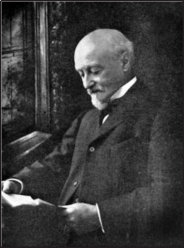- CHANUTE
- FRANCE (see also List of Individuals)\
 18.2.1832 Paris/F - 23.11.1910 Chicago/USA\Octave Canute's father accepted the appointment of vice-president at Jefferson College in Louisiana in 1838. His son started the career from the foot of the ladder in developing transportation on land and in the air, of which only the latter aspect is considered. Chanute became interested in aviation in 1874. In 1889, he moved to Chicago and from then seriously contributed to questions of human flight. He presided over the Western Society of Engineers in 1901 and was elected its Honorary Member in 1909. He also was an Honorary Member of the British Institution of Civil Engineers from 1895 and the Canadian Society of Civil Engineers.\Chanute's first work in aviation was published in 1891 in a journal and in 1894 in book form; it summarizes the experiments in flight conducted over the past centuries. This work was significant in the development of aviation because all experiments on the subject matter were reviewed and it directed to the future progress. At about this time, Otto Lilienthal (1848-1896) made his successful gliding experiments near Berlin, inducing Chanute to build a Lilienthal glider and to attempt experiments with man-carrying models in continuation of his previous works with small models. The site chosen was Dune Park near Gary, on the sand dunes of Indiana. Unlike the unfortunate Lilienthal, who passed away during a flight, Chanute made almost 200 flights free from misadventure. The Lilienthal glider was abandoned because it required a great skill in keeping stability. Chanute chose the biplane, which served also to the Wright brothers later. These experiments were described in the 1897 paper. All these experiments were made free of any economical interests and served exclusively to science. In 1910, Chanute published a further paper to describe the bewildering record of successful flights achieved until then, giving the complete chronology of aviation from the first flight of Wright to October 1909. Lilienthal, Chanute, Langley and Maxim are considered four names that remain inseparably linked with early flight, therefore.\Anonymous (1911). Octave Chanute. Trans. ASCE 74: 483-489. PChanute, O. (1894). Progress in flying machines. American Engineer and Railroad Journal: New York.Chanute, O. (1897). Gliding experiments. Journal of Western Society of Engineers 2: 593-628. Chanute, O. (1903). Aerial navigation. Science Press: New York.Chanute, O. (1911). Recent progress in aviation. Journal of Western Society of Engineers 15(2): 111-147.
18.2.1832 Paris/F - 23.11.1910 Chicago/USA\Octave Canute's father accepted the appointment of vice-president at Jefferson College in Louisiana in 1838. His son started the career from the foot of the ladder in developing transportation on land and in the air, of which only the latter aspect is considered. Chanute became interested in aviation in 1874. In 1889, he moved to Chicago and from then seriously contributed to questions of human flight. He presided over the Western Society of Engineers in 1901 and was elected its Honorary Member in 1909. He also was an Honorary Member of the British Institution of Civil Engineers from 1895 and the Canadian Society of Civil Engineers.\Chanute's first work in aviation was published in 1891 in a journal and in 1894 in book form; it summarizes the experiments in flight conducted over the past centuries. This work was significant in the development of aviation because all experiments on the subject matter were reviewed and it directed to the future progress. At about this time, Otto Lilienthal (1848-1896) made his successful gliding experiments near Berlin, inducing Chanute to build a Lilienthal glider and to attempt experiments with man-carrying models in continuation of his previous works with small models. The site chosen was Dune Park near Gary, on the sand dunes of Indiana. Unlike the unfortunate Lilienthal, who passed away during a flight, Chanute made almost 200 flights free from misadventure. The Lilienthal glider was abandoned because it required a great skill in keeping stability. Chanute chose the biplane, which served also to the Wright brothers later. These experiments were described in the 1897 paper. All these experiments were made free of any economical interests and served exclusively to science. In 1910, Chanute published a further paper to describe the bewildering record of successful flights achieved until then, giving the complete chronology of aviation from the first flight of Wright to October 1909. Lilienthal, Chanute, Langley and Maxim are considered four names that remain inseparably linked with early flight, therefore.\Anonymous (1911). Octave Chanute. Trans. ASCE 74: 483-489. PChanute, O. (1894). Progress in flying machines. American Engineer and Railroad Journal: New York.Chanute, O. (1897). Gliding experiments. Journal of Western Society of Engineers 2: 593-628. Chanute, O. (1903). Aerial navigation. Science Press: New York.Chanute, O. (1911). Recent progress in aviation. Journal of Western Society of Engineers 15(2): 111-147.
Hydraulicians in Europe 1800-2000 . 2013.
